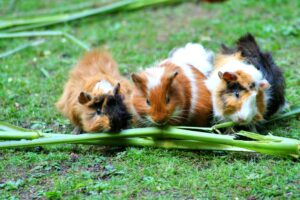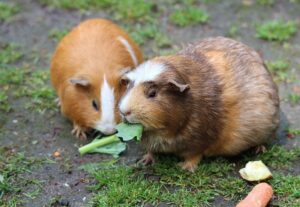Understanding the Himalayan Guinea Pig: A Comprehensive Guide for Himalayan Guinea Pig Owners

As a seasoned guinea pig expert, I’m here to shed light on the captivating world of Himalayan guinea pigs, a breed cherished for its unique appearance and charming personality traits. These gentle creatures have a distinct set of needs and characteristics that every responsible guinea pig owner should be aware of.
**1. The Striking Appearance of Himalayan Guinea Pigs**
Himalayan guinea pigs are true eye-catchers with their signature appearance. Their snow-white coat serves as a canvas for contrasting color points on their ears, nose, paws, and tail, which are typically dark brown or black. This coloration is reminiscent of the famous Siamese cats. It’s not just their looks that make them stand out; it’s also their engaging personality.
**2. The Friendly and Sociable Nature**
One of the most endearing qualities of Himalayan guinea pigs is their sociable disposition. They thrive on human interaction and are known for their friendliness. These furry companions are quick to form bonds with their owners, making them an ideal choice for families and individuals seeking a loving and personable pet.
**3. A Balanced Diet for Optimal Health**
To keep your Himalayan guinea pig in top health, a balanced diet is crucial. These creatures thrive on a diet rich in high-quality hay, fresh vegetables, and a small portion of pelleted guinea pig food. Since they are unable to synthesize their own vitamin C, which is essential for their health, it’s vital to provide foods high in this vitamin or consult with a veterinarian about supplements.
Here is a table of the different foods to feed your pet Himalayan guinea pig:
| Food Type | Benefits | Average Cost (per month) |
|---|---|---|
| Fresh Hay | Essential for dental health, aids digestion, provides fiber | $5 – $10 |
| Fresh Vegetables | Vitamin C, additional nutrients, variety in the diet | $5 – $10 |
| Pelleted Guinea Pig Food | Balanced nutrition, vitamin C supplementation | $5 – $10 |
| Fresh Fruits | Occasional treat, vitamin C, variety in taste | $5 – $10 |
| Fresh Water | Hydration, essential for overall health | Minimal |
**4. Housing and Habitat**
Guinea pigs, including Himalayans, need ample space and a clean environment. A spacious cage with hiding spots or shelters for security is a must. Opt for comfortable and absorbent bedding. Keep their habitat dry and well-ventilated, steering clear of drafts and direct sunlight.
**5. The Importance of Companionship**
Himalayan guinea pigs are inherently social animals. They thrive when they have a companion, so consider adopting a pair if circumstances allow. Ensure that the personalities of the guinea pigs are compatible, as this greatly influences their well-being.
**6. Grooming Rituals**
Due to their long and dense fur, Himalayan guinea pigs require regular grooming to prevent matting and maintain cleanliness. Brushing their fur at least once a week not only keeps them comfortable but also deepens your bond.
**7. Health Vigilance**
Guinea pig owners must be vigilant about their pets’ health. Common health issues include dental problems, respiratory infections, and obesity. Regular veterinary check-ups are essential to catch and address health concerns promptly.
**8. Gentle Handling and Taming**
Himalayan guinea pigs benefit from gentle handling and taming. Approach them calmly, offering treats and speaking softly to build trust. Patience is key as they acclimate to being handled.
**9. Optimal Environmental Conditions**
These delicate creatures are sensitive to extreme temperatures. Maintain a consistent and comfortable environment, ensuring they’re sheltered from cold drafts and excessive heat, and always have access to clean water and fresh hay.
**10. A Long-Term Commitment**
Lastly, Himalayan guinea pigs have a lifespan of 5 to 7 years or longer with proper care. Be prepared for the rewarding, long-term commitment that comes with welcoming one of these remarkable animals into your life.
In conclusion, Himalayan guinea pigs are not just pets; they are companions with unique needs and charming personalities. Providing them with the proper care, attention, and love will reward you with years of joyful companionship and delightful interactions.
Free Reports
- Cockatiel Sounds: What Type of Sounds Do Cockatiels Make?
- Cane Corso Lab Mix: What You Need To Know Before Adopting Your New Cane Corso Lab Mix
- Belgian Malinois Grooming: How to Properly Care For Your Belgian Malinois
- Hamster Vomiting: What You Need To Do When Your Hamster is Vomiting
- Manchester Terrier Price: What You Should Before Adopting Your Manchester Terrier
- Boerboel Life Span: How Long Do Boerboel Dogs Usually Live?
- Canaan Dog Price: Everything You Should Know About Canaan Dogs Before Adopting
- Do Cane Corso Shed: How Much Cane Corsos Shed and How to Prevent Shedding
- Cane Corso German Shepherd Mix: Everything They Don’t Tell You About This Unique Mix
- Cane Corso Doberman Mix: Check Before You Buy! What They Don’t Tell You About Cane Corso Doberman Mixes
- Brindle Cane Corso: What You Need to Know Before Adopting
- Cockatiel Eye Problems: What to Do When Your Cockatiel Has an Eye Infection
- Top 25 Sun Conure Names: How to Name a Sun Conure, Care Tips and Tricks
- Friesian Horse Price: Everything You Need to Know Before You Buy a Friesian Horse
- Friesian Colors: The Uniqueness of Every Friesian Horse Color, Price and Care Tips
